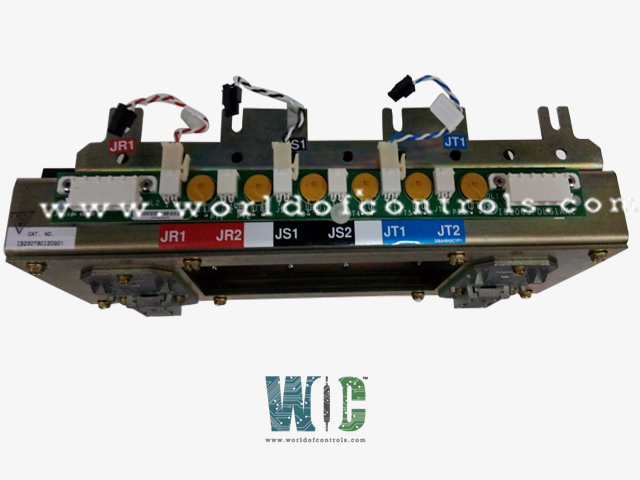
World Of Controls understands the criticality of your requirement and works towards reducing the lead time as much as possible.
IS230TBCIH4C - Contact Input with Group Isolation Terminal Board is available in stock which ships the same day.
IS230TBCIH4C - Contact Input with Group Isolation Terminal Board comes in UNUSED as well as REBUILT condition.
To avail our best deals for IS230TBCIH4C - Contact Input with Group Isolation Terminal Board, contact us and we will get back to you within 24 hours.
SPECIFICATIONS:
Part Number: IS230TBCIH4C
Manufacturer: General Electric
Series: Mark VI
Product Type: Group Isolation Terminal Board
Number of channels: 24
Excitation Voltage: 125 V dc
Power Consumption: 20.6 W
Power supply voltage: 28 V dc
Voltage Range: 14 to 32 V dc
Mounting: DIN-rail mounting
Technology: Surface mount
Operating temperature: -30 to 65°C
Size: 33.02 cm high x 10.16 cm
Repair: 3-7 Day
Availability: In Stock
Country of Origin: United States
Manual: GEH-6721_Vol_II
FUNCTIONAL DESCRIPTION:
IS230TBCIH4C is a Contact Input with a Group Isolation Terminal Board manufactured and designed by General Electric as part of the Mark VI Series used in GE Speedtronic Gas Turbine Control Systems. The Contact Input with Group Isolation (TBCI) terminal board supports 24 dry contact inputs connected via two barrier-type terminal blocks. DC power is supplied to the TBCI for contact excitation. It features noise suppression circuitry to guard against surges and high-frequency interference. The TBCI is compatible with the PDIA I/O pack and supports simplex, dual, and TMR configurations. Up to three PDIAs can connect directly to the TBCI. The Mark VIe control requires the C version of this board to ensure proper mechanical alignment of connector JT1 with the I/O pack support.
INSTALLATION:
Wire the 24 dry contact inputs directly to two I/O terminal blocks on the terminal board. Secured with two screws, these blocks can be unplugged for maintenance. Each block accommodates 24 terminals supporting wires up to #12 AWG. A shield terminal strip connected to the chassis ground is positioned to the left of each terminal block.
In a simplex system, connect the TBCI to the PDIA I/O pack via connector JR1. For a TMR system, use connectors JR1, JS1, and JT1 to link the TBCI to three PDIAs. The PDIAs mount directly onto the TBCI and attach to side brackets. One or two Ethernet cables connect to the I/O pack, and firmware updates may be required. Use plugs JE1 and JE2 to connect the TBCI to the contact excitation voltage source.
OPERATION:
Filters minimize high-frequency noise and suppress surges at the signal entry point for each input. The dry contact inputs on the TBCI_1C are powered by a floating 125 V DC supply (100-145 V DC) from the turbine control system. The 125 V DC bus is current-limited in the power distribution module before supplying each contact input.
The discrete input voltage signals are routed to the PDIA I/O pack, which uses optical isolators for group isolation before transmitting the signals to the Mark VIe controller. The isolation circuit's reference voltage establishes a transition threshold at 50% of the applied floating power supply voltage. Tracking is clamped to a minimum of 13% of the nominal supply voltage, ensuring all contacts are open if the voltage drops below this level.
Each input is assigned a pair of terminal points: one for the positive DC source and the other for the return (input) to the board. The first 21 inputs on each terminal board have a current load of 2.5 mA per point, while the last three inputs handle a 10 mA load to interface with remote solid-state output electronics. The contact input circuitry complies with NEMA Class G creepage and clearance standards.
WOC has the largest stock of Replacement parts for GE Speedtronic Gas turbine control systems. We can also repair your faulty boards and supply unused and rebuilt boards backed up with a warranty. Our team of experts is available round the clock to support your OEM needs. Our team of experts at WOC is happy to assist you with any of your automation requirements. For pricing and availability on parts and repairs, kindly contact our team by phone or email.
How is the TBCI connected to the PDIA I/O pack?
In a simplex system, the TBCI connects to the PDIA I/O pack via connector JR1. In a TMR system, it connects to three PDIAs using connectors JR1, JS1, and JT1.
What is the input current load for the TBCI terminal board?
The current load is 2.5 mA per point for the first 21 inputs. The last three inputs have a 10 mA load for interfacing with remote solid-state output electronics.
How are high-frequency noise and surges suppressed on the TBCI?
Each input is equipped with filters to reduce high-frequency noise and suppress surges near the signal entry point.